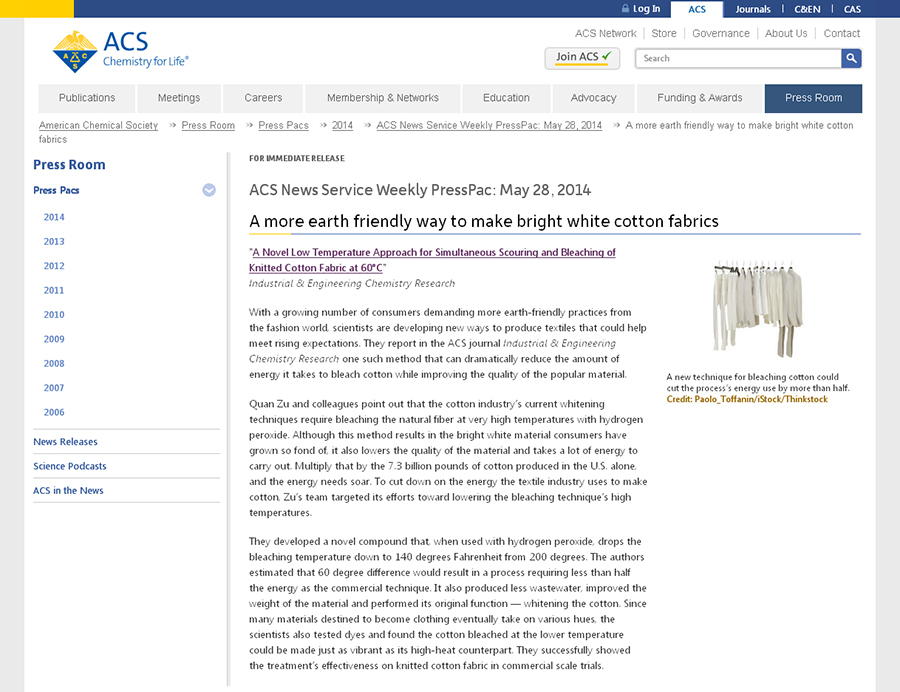2014年5月28日,在美国化学学会(ACS)的杂志Industrial &Engineering Chemistry Research(IECR)即工业与工程化学研究杂志,发表了我公司有关低温练漂的研究论文:《A Novel LowTemperature Approach for Simultaneous Scouring and Bleaching of Knitted CottonFabric at 60°C》(一种在60℃对棉针织物同时进行精练和漂白的新型低温加工工艺),为此,ACS的新闻周刊还专门撰文介绍,题目为“A more earth friendlyway to make bright white cotton fabrics”(一种更加环保的棉织物漂白方法)。
美国化工学会网站发表文章截图
Amore earth friendly way to make bright white cotton fabrics
"ANovel Low Temperature Approach for Simultaneous Scouring and Bleaching ofKnitted Cotton Fabric at 60°C"
Industrial& Engineering Chemistry Research
Witha growing number of consumers demanding more earth-friendly practices from thefashion world, scientists are developing new ways to produce textiles thatcould help meet rising expectations. They report in the ACS journal Industrial& Engineering Chemistry Research one such method that can dramaticallyreduce the amount of energy it takes to bleach cotton while improving thequality of the popular material.
QuanZu and colleagues point out that the cotton industry’s current whiteningtechniques require bleaching the natural fiber at very high temperatures withhydrogen peroxide. Although this method results in the bright white materialconsumers have grown so fond of, it also lowers the quality of the material andtakes a lot of energy to carry out. Multiply that by the 7.3 billion pounds ofcotton produced in the U.S. alone, and the energy needs soar. To cut down onthe energy the textile industry uses to make cotton, Zu’s team targeted itsefforts toward lowering the bleaching technique’s high temperatures.
Theydeveloped a novel compound that, when used with hydrogen peroxide, drops the bleachingtemperature down to 140 degrees Fahrenheit from 200 degrees. The authorsestimated that 60 degree difference would result in a process requiring lessthan half the energy as the commercial technique. It also produced lesswastewater, improved the weight of the material and performed its originalfunction — whitening the cotton. Since many materials destined to becomeclothing eventually take on various hues, the scientists also tested dyes andfound the cotton bleached at the lower temperature could be made just asvibrant as its high-heat counterpart. They successfully showed the treatment’seffectiveness on knitted cotton fabric in commercial scale trials.
原文翻译如下:
一种更加环保的棉织物漂白方法
“一种在60℃对棉针织物同时进行精练和漂白的新型低温加工工艺”工业与工程化学研究
随着越来越多的消费者要求在世界上实施更环保的生产方式,科学家们正在开发新的方法来生产纺织品,可以帮助满足这种不断提高的期望。现在ACS的工业与工程化学研究期刊上刊登了一个这样的方法,可以大大减少漂白棉织物所花费的能源,同时还能提高这种广泛应用材料的质量。
朱泉教授和他的同事们指出,目前工业上棉花漂白技术是在很高的温度下使用过氧化氢来漂白的。虽然这种方法生产的精白棉织物很受消费者青睐,但它降低了材料的质量并耗费了大量的能源。仅在美国生产的棉就有73亿磅(331万吨),能耗极其巨大。为在纺织生产中减少棉加工的能耗,朱教授的研究团队以降低漂白温度为目标做了深入研究。
他们开发出一种新型化合物,与过氧化氢使用时,可使棉的漂白温度从华氏200度(95℃)下降到140度(60℃)。作者估计这60度(华氏)的差异可使生产过程需要的能量减少一半以上。这一技术在漂白棉花的同时,还能减少废水排放,增加加工后棉的重量。因为用做服装的许多材料需要染色,这些研究者还测试染色性能,并发现在较低的温度下漂白的棉织物其各种性能与相应的高温漂白的棉织物相当。他们也成功地在工业生产设备上对棉针织物进行了练漂试验,证明了此法的有效性。
